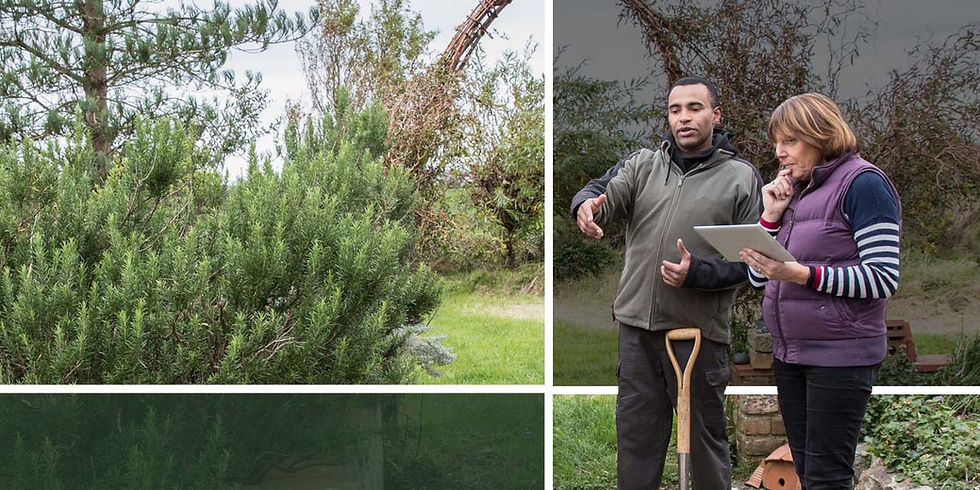Tree Pruning 101 for Marylanders
- Rooted in Nature

- Mar 1, 2021
- 3 min read
Updated: Apr 30, 2024
The winter weather in Maryland will no doubt have a serious affect on your trees limbs this coming spring. Pruning is as important to your tree as getting your annual doctor’s checkup. Pruning helps to prevent the spread of disease, promote a long livelihood, and direct the growth pattern of your tree. We here at Rooted In Nature believe in sharing our knowledge with you, which is why we have created the Tree Pruning guide below.

WINTER PRUNING – WHAT IS IT AND WHY DO IT?
Many people associate tree pruning with tree trimming. Tree pruning focuses on the removal of dead or infected limbs to support the health of the tree, whereas tree trimming focuses on the design and aesthetics of the tree. Winter pruning is important to keeping your trees healthy. Typically, this pruning should concentrate on promoting a natural look for the tree to highlight its best features, as well as preserving the well-being of the tree. You will want to remove any dead or diseased branches so that the damaged branches do not threaten the vitality of the healthy limbs. Be cognizant to not over-prune, as the lack of leaves in the growing season can be harmful to the tree.
THE BEST TIME TO PRUNE
There are many benefits to winter pruning. The best time for tree pruning in Maryland is in the winter, when the trees are dormant. Certain species of trees must be pruned while dormant to minimize the spread of tree disease. American elm trees must be pruned while dormant to eliminate entry points for Dutch elm disease. Apples, crabapples and mountain ash are pruned while dormant to prevent the spread of fireblight (a contagious disease that gives plants a scorched appearance, and can destroy entire orchards).
Dormant pruning allows for successful and accurate pruning as arborists are able to visibly see the complete structure of the tree. Pruning in the winter lessens the chance for disease and insect problems because sap flow is not occurring. This reduces the points of entry as the tree will begin to heal while the insects and diseases lie dormant in the winter months. Shrubs benefit from winter pruning as well. By removing older stems, the shrub will be able to receive more airflow and sunlight which allows more vigorous growth - and can reduce pest problems.
TOOLS YOU’LL NEED TO GET STARTED
To properly prune trees and shrubs, you will need the following tools:
Hand pruners: Pruners are handheld shears commonly used for pruning shrubs and small growths on trees. They are used to cut twigs and branches from ¼ to ¾ inch in diameter (depending on the hand pruners you purchase).
Loppers: Similar to hand pruners, except with much longer handles. Loppers can cut branches up to 2.5 inches in diameter.
Pruning saw: Pruning saws are great for cutting branches larger than 2.5 inches in diameter. They are handheld with coarse teeth to create a smooth cut.
Pole pruner: For those branches that are out of your reach, use a pole pruner. Pole pruners are long poles with a pruning saw attached at the top.
Hedge shears: Hedge shears are best suited for shrubs and hedges. The look is very similar to a lopper but with a much longer blade.
The ability of your tools and how much they can cut will depend on the make and model. Keep your tools sharp and clean to make pruning a quick task and to avoid spreading diseases from one tree to another.
TREE PRUNING TECHNIQUES:
Tree pruning in Maryland is important for both young and mature trees. Pruning young trees is imperative to the development of a strong structure as the tree grows. Not pruning (or improperly pruning) young trees can result in deformation or a weakened structure. Pruning mature trees focuses on minimizing limb failure and maintaining tree health and vigor. This means pruning out dead and broken branches, reducing weight where needed and canopy-raising for mature trees. Below are arborist-approved tree pruning techniques that your trees will thank you for.
Pruning large branches (large branches require 3 cuts to avoid tearing the tree bark that causes harm to the tree):
Create an undercut between 12” to 24” from the branch collar.
Cut the branch all the way through about 1” away from the undercut, so that you have completely removed the branch safely and are left with a nub.
Cut through just beyond the branch collar.
Pruning small branches and twigs. There are two ways to shorten a smaller branch:
Cut the branch to a side branch.
Cut the branch about ¼ inch above the bud.
Every tree is different - from its type, to its maturity, to its size - so make sure you consult with Rooted In Nature before pruning and cutting tree limbs. Please feel free to contact us at 443-846-0199 or info@rootedinnaturemd.com.



Comments